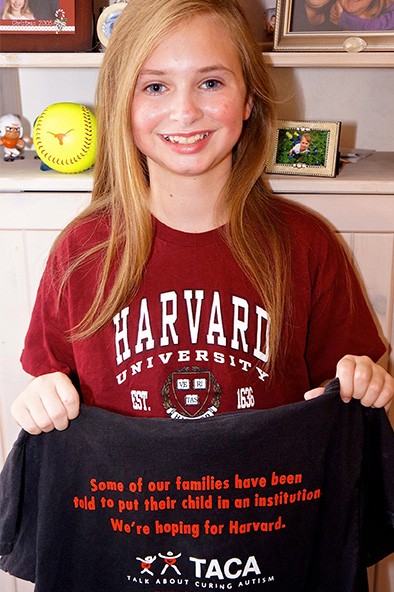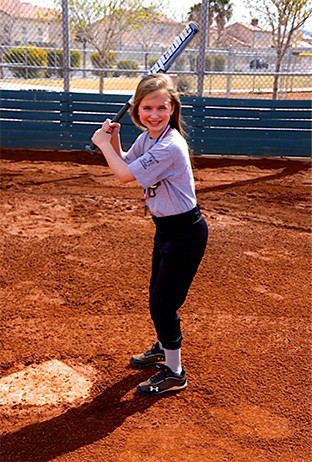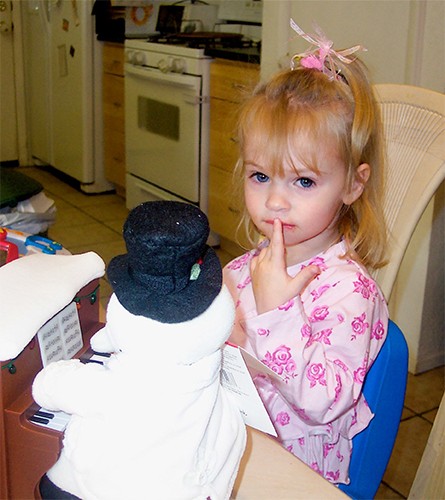Full Story
Music to Our Ears
by Brandy Vaughn

All contents of this resource were created for informational purposes only and are not intended to be a substitute for professional advice, diagnosis, or treatment. Always seek the advice of your physician, therapist, or other qualified health providers with any questions or concerns you may have.
My daughter, Ryan, was born December 4, 2002. Three and a half years later, she was diagnosed with autism. I became concerned about her development at age 2 ½, when she didn’t answer to her name, protested any demand placed on her, and was extremely tactile-defensive. If we met people for dinner, even those she knew well, we had to arrive late and approach the table with everyone already seated. If anyone approached the table after we were seated, she threw herself out of the high chair and tried to hide, even if it was her own dad. Her speech was also delayed and difficult to understand. Since she had had so many ear infections, I thought perhaps she couldn’t hear and that was why she seemed so frustrated and uncomfortable. She was eventually diagnosed with mild-moderate hearing loss on the left side and it was sensory neural (permanent). Well, that explained everything! She really couldn’t hear. Ear tubes were put in, but we needed a hearing test to be completely sure, and she would not cooperate with having earphones placed on her.
Meanwhile, I noticed that Ryan was not at all conversational. We regularly attended a play group, where her favorite playmate who was seven months younger was conversational. Ironically, the play group had Early Intervention specialists attend the twice each month, but none of them ever picked her out of the crowd.
Since we knew she had special needs with her hearing, we had her tested by our local school district at age 3. Two days before her 3rd birthday was the worst day of our lives. They said that they thought she had “characteristics” of autism. We sat in stunned silence as autism wasn’t even on our radar. I had prayed so hard for a healthy child and one without autism. And she was a girl! How could she have autism?!! There would be no more children for my husband as we had to have in-vitro (IVF) to get Ryan. And, after a very complicated pregnancy, I had to have an emergency hysterectomy during the c-section delivery. God was telling me loud and clear that we would need all of our focus, energy and time for Ryan, and Ryan only.
We took Ryan to a Developmental Pediatrician at UCLA. She was having a good day, and he declared her to not be on the autism spectrum. But he did recommend ABA (Applied Behavior Therapy) for her behavioral issues. I didn’t know it at the time, but ABA was THE treatment for autism. So tell me again that she’s not on the spectrum?
Two weeks later, we took her to a well known children’s hospital in Texas, where Ryan completed her hearing test, the results of which were completely normal. Now I knew for sure that something was terribly wrong. I could no longer blame her behaviors on hearing loss. And to top that off, no one believed that anything was wrong with Ryan, much less autism. After all, she could talk, but only in 2-3 word sentences. My husband said I was just looking for trouble and why couldn’t I just be happy that she didn’t have hearing loss. My best friend, who had been around a lot of autism, just “didn’t see it.” Even my own mother didn’t believe, or want to believe, something was wrong with her granddaughter. But I also knew with every fiber of my being that something was very wrong and I was not going to let my daughter slip away into a world of isolation.
About a month after her 3rd birthday, I saw Ryan’s first signs of self-stimulatory behavior (stimming), when she started spinning a toy and flapping and flicking her hands. But she still didn’t fit most of the criteria of autism that I had found until semantic/pragmatic disorder popped up under autism spectrum disorder on a Google search. Finally, I knew without a doubt that she was on the spectrum. I checked almost every box showing the signs and symptoms. Autism, without a shred of doubt. I was so excited, I woke my husband to tell him. I wasn’t happy about autism, but I was thrilled I had a diagnosis. I could battle it now. I could put a name into a search engine and research the hell out of it! My research also told me that autism was expensive, so we took out a second mortgage on our house so we wouldn’t have to wait to begin therapies.
Three months before the “official” diagnosis, I started Ryan on the gluten-free, casein-free diet (GFCF), found a DAN (Defeat Autism Now) doctor, and moved to San Jose, California to stay with my sister-in-law so Ryan could do Tomatis Listening Therapy, which was unavailable in Las Vegas, where we live. At 3 1/2 years, the official diagnosis came and we started ABA, full-time preschool with the school district, occupational therapy, and were still traveling back and forth between Vegas and San Jose every three weeks for Tomatis. Ryan didn’t have time to be autistic!
We found that Ryan was a “responder,” meaning that she generally improved with every intervention that we threw at her. We soon learned that the interventions that started out with negative effects were the ones that later produced the most profound improvements. At that point, Tomatis and ABA were the top interventions. Diet didn’t yield the big ah- hah’s at first, but after removing potatoes from her diet, the fog literally lifted. She was so much more present and focused. That’s when I realized how powerful food and nutrition were going to be in her journey.
By age 4, Ryan was sick with colds and upper respiratory infections all winter. The pediatricians wouldn’t listen, so our DAN doctor ran an immune panel and — bingo!! — she was immune deficient. Treatment was intravenous immune globulin therapy (IVIG). The two immunologists we saw in Vegas were unacceptable, so we drove once monthly to Irvine, California for Ryan’s infusions. It was there that I met another mom who told me about TACA. Finally, an organization that already had done a ton of research, and it was all at my fingertips on my computer.
TACA saved me so much time, especially in Whole Foods with my list of hidden gluten and casein ingredients.bMy normal 3 to 4 hours of shopping was cut down to 1 to 2 hours. I learned more from other moms dealing with autism than I did from any other source. I asked another autism mom how she detoxified her son after swimming in a chlorine pool. She gave me her formula, which involved taurine. We tried it and, almost instantly, Ryan improved to a new level. We were climbing stairs one by one, and taurine brought us two steps closer to recovery. This same TACA mom also knew what was wrong when my daughter started throwing up at school. We had started a new prescription digestive enzyme and it had had the same effect on her son. She saved me from having to remove and reintroduce supplements to determine which one was causing the problem. Just the feeling of not being alone and having a huge support and advice system of parents going through the same thing was invaluable. And finding other parents who were further down the road on their journey was priceless. It saved time and money to hear what was and wasn’t working for their kids.
We also found out how damaged Ryan’s gastrointestinal (GI) system was after she had her first upper endoscopy and colonoscopy. Her colon wasn’t so bad, however, her stomach, particularly the lower part, called the duodenum, was severely damaged. Ryan was diagnosed with acute duodenitis (inflammation), hemorrhagic gastritis (bleeding in her stomach, and aphthous ulcers (erosions). Her GI doctor was astonished that she was a relatively happy child because she should have been in significant pain. But Ryan had always had a very high tolerance for pain. The GI news was the most devastating so far, even more so than autism. Knowing that your child lives with severe pain every day and is unable to communicate that, or simply is so used to living with it that you as a parent were completely unaware of it is….there isn’t a word strong enough, maybe at least “crushing,” to describe how this felt to me.
We had heard about Hyperbaric Oxygen Therapy for autism. As a Registered Nurse, I knew it was widely used to heal wounds. We heard there was a HBOT center in Irvine, California, and we were already going once monthly for IVIG, so we added HBOT to Ryan’s regimen. At this point, our second mortgage money was gone and my husband, a police officer, was forced to transfer to another area command that had a great deal of overtime. He often worked three to four 16-hour shifts per week, and worked on his days off as well, to keep all of Ryan’s therapies going and paying for new ones. I was pretty much a single mom, and Ryan didn’t get to see her dad much at all. My full time job was getting Ryan well.
HBOT was HUGE for Ryan and I would rank it #1 or tied with a couple of others as the best therapy we tried. She made improvements across the board — more conversational, more engaged, improved eye contact, constipation lessened, and her stool was looking more normal.
Two months after beginning HBOT, Ryan had her second evaluation by the neuro-psychologist who had diagnosed her with autism one year earlier. This was a turning point and one of the best days of our lives. The psychologist literally stammered over her words as she described the dramatic improvements in every category of her testing. Ryan was no longer in the “neurological danger zone.” She had not only moved out of the danger zone, she was significantly out of it. According to the psychologist, she was still on the spectrum because “autism is in the brain” and therefore always present. We didn’t care! The improvements were obvious and now it was clearly documented. Biomedical treatments were working and it gave us renewed energy to stay focused, continue our research and add more therapies. Every year Ryan was reevaluated and tested by her neuro-psychologist, who every year saw the dramatic improvements and encouraged us to keep doing whatever it was we were doing. However, she still had Ryan on the spectrum, albeit more on the Asperger end. In 2011, she finally admitted that if there is such a thing as recovery from autism, then we had it. That was one of our best days!
Autism is a thing of the past for Ryan, but her GI issues have remained. In 2010, they worsened to the point of having to put her on an elemental diet (liquid baby formula) called Elecare. She has not eaten solid food for 3 1/2 years. It sounds horrible and it was heart wrenching, but it has been a mixed blessing. Ryan was 7 years old and weighed only 37 pounds. She had fallen off the growth chart and was scary thin. You could count every vertebrae and rib. Anytime we would get a few pounds on her, she would get sick or have her yearly Fall flare and drop several pounds almost instantly. That year had been a particularly bad flare and we couldn’t seem to get her out of it.
Although her doctor said we could start her back on food slowly, Ryan has refused. She remembers how badly her tummy hurt before Elecare. We just returned from Boston to get a second opinion on her GI issues. Her upper endoscopy and colonoscopy looked really good, no blood or ulcers noted. We are waiting on the pill-cam and pathology reports. Ryan handled the testing like the trooper she has always been. She rolls with every change or intervention, which makes it so much easier on us. She seems to sense when changes are coming and even when we removed solid food, she just went with it. While the GI issues remain, we celebrate every victory.
So far, Ryan does not have seizures. She attends a private Christian school and has since Kindergarten, completely aide-free. She struggles at times with focus and attention. This is usually related to her GI issues and when our allergy seasons peak. She is indistinguishable from her peers and is in the upper 1/3 of her class. She will begin 5th grade soon and reads several years above grade level with comprehension.
Last Fall, Ryan tried out for girls fast pitch softball and made the team! She is truly out there on her own, playing just like all the other girls. Now we are the proud parents in the stands, screaming the loudest for our girl. None of the other parents or the coach have any idea of her previous diagnosis of autism. Her team won the championship the first year Ryan played and she was instrumental in that achievement.
I promised my daughter and myself that I would not give up on her, ever. Sitting in a rocking chair in our old age, my husband and I will be able to look back and know we did everything in our power to make her well again and able to live a full and productive life. She’s almost 11 and has all the signs and symptoms of normal teenage angst. She will argue about anything, gives the most obnoxious eye rolls, and generally wears us down to get what she wants. “Normal” and “typical” are two words often used to describe her by her teachers when she has gotten into mischief. Music to our ears!


